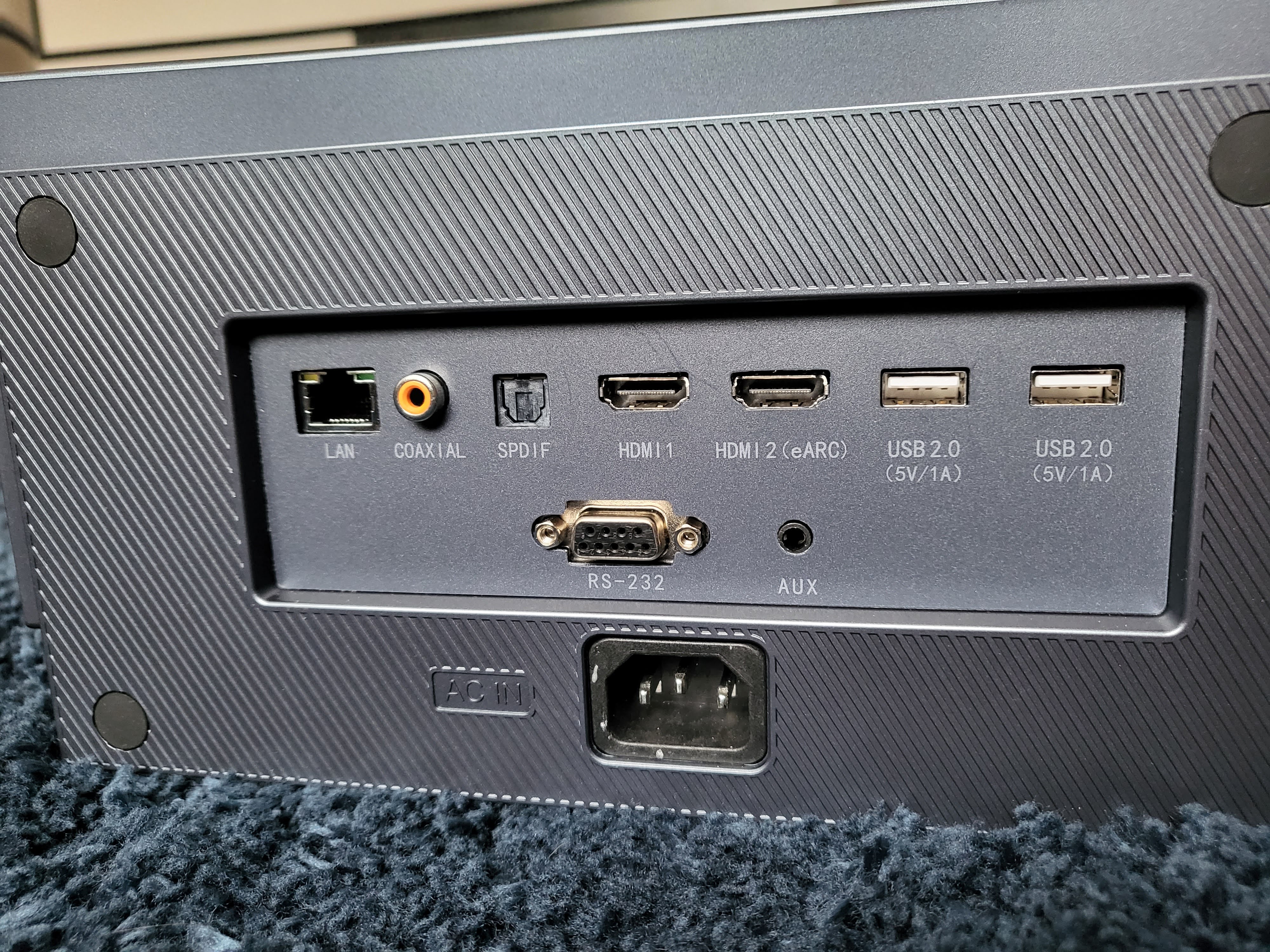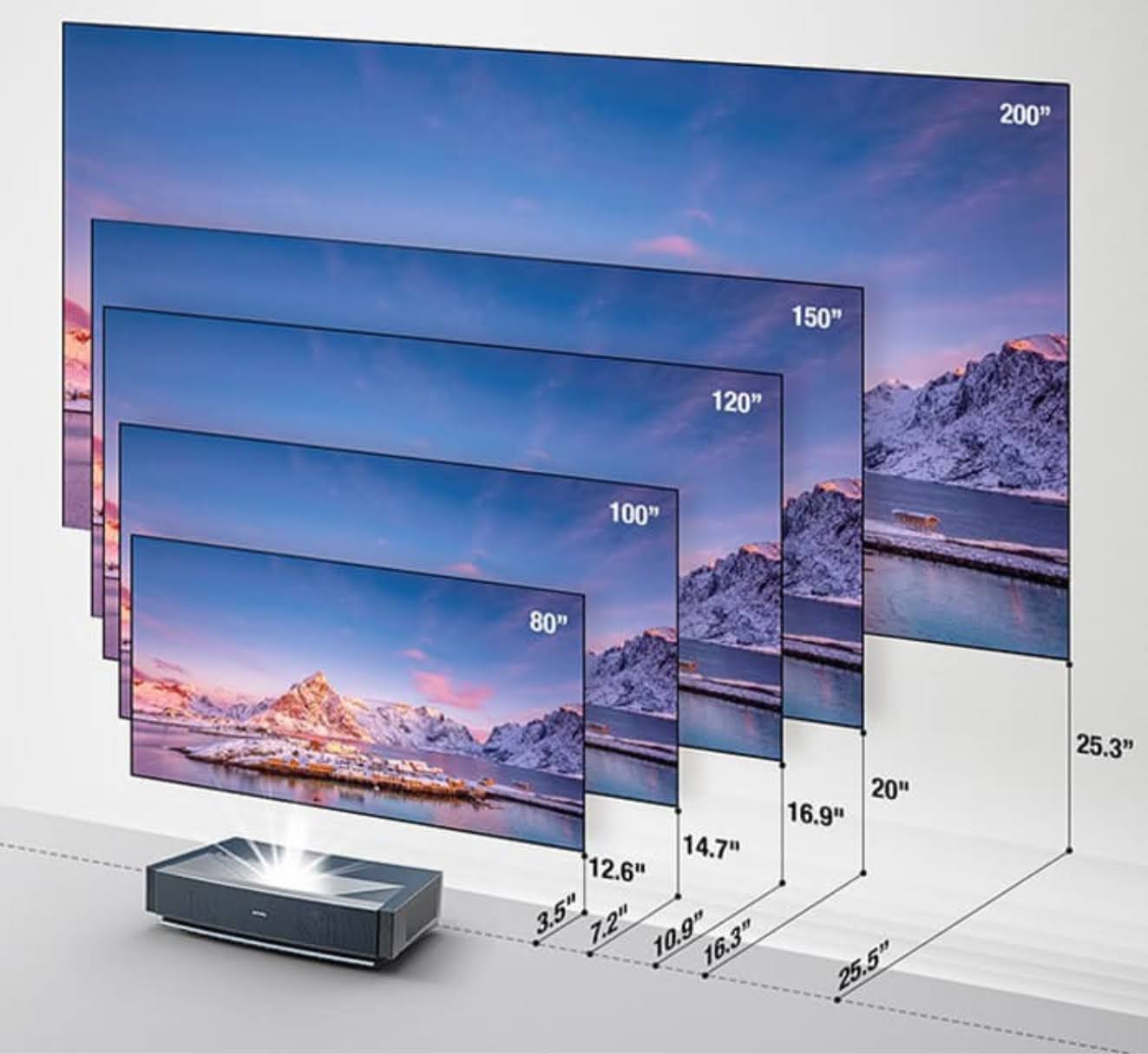TechRadar Verdict
The Ultimea Thor T60 shines, literally and metaphorically behind closed curtains, in pitch black darkness. This 4K UST projector delivers exceptionally bright pictures with an introductory price tag that’s reasonable. The biggest issue remains the lack of credentials but then again, every startup has to start somewhere.
Pros
- +
Brighter than the competition
- +
Exceptional image quality
- +
Satisfactory audio performance
- +
3D capable
Cons
- -
A focus wheel would have been preferable
- -
Only two HDMI ports
- -
Long term support is an unknown
- -
The suggested retail price is expensive
- -
The remote control could be better designed
- -
No lens cover or flap
Why you can trust TechRadar
Kickstarter hosts another manufacturer that aspires to become the leader in busy 4K UST (Ultra Short Throw) projector market. Ultimea is throwing its hat in the ring with the Thor T60, a larger-than-average projector that aims to distinguish itself from the plethora of other obscure Chinese vendors selling so-called triple laser TV with outlandish specifications.
Its unique selling point holds in one number: 4,000. That’s the amount of lumens the T60 claims to deliver and there’s at least one independent test that backs this number. At the time of writing, it is probably the brightest 4K tri-laser UST projector south of $10,000 which makes it a potential candidate for daylight viewing (don’t expect miracles though).
And boy does it deliver. The brightness difference between, say a Bomaker Polaris 4K and the T60, is significant, especially in reasonably broad daylight and that directly influences the image quality. The end result is a visual feast, a colorful punch in the face, especially if you want to scale to beyond 150-inch diagonal, which tests the projector’s picture performance to breaking point.
Its sticker price puts its squarely in the same league as the LG Cinebeam HU915QE, JVC DLA-NZ8 and Samsung The Premiere but I expect the inflated price to drop down permanently.
Given its superb cinematic performance, the T60 could be a game changer for businesses as well, especially for exhibitions and live events where the ability to rapidly setup large format displays, without the usual logistical nightmares, could save thousands of man hours.
Just remember though that, no projector however expensive can match a TV - especially an OLED one - in daylight because of the non-emitting nature of the technology. Once curtains are drawn however, these beasts come to life.

Ultimea Thor T60: Price and release date
Ultimea has already surpassed its goal of £40,300 (about AU$77,000, $49,300) at the time of writing with a total of 58 backers committing a staggering £194,679 (about AU$371,500, $238,400) with 31 days to go. The early bird price of the T60 which includes two 3D Glasses currently stands at £3,104 (about AU$5,926, $3,799) with an estimated delivery date of November 2023. 40 units are currently available. All Kickstarter backers also get a free Firestick TV stick or $50 Netflix credit, a nice gesture that I think should be extended.
Sign up to the TechRadar Pro newsletter to get all the top news, opinion, features and guidance your business needs to succeed!
While we have no reason to believe that this project won’t be successful, it is important to understand the risks associated with crowdfunding. Please do read our feature on this (when crowdfunding campaigns go bad) and Kickstarter’s own paragraph highlighting the risks and challenges associated with this campaign. The Ultimea Thor T60 is expected to be released to backers towards the end of November 2023, beginning of December 2023.

Ultimea Thor T60: Specs
The T60 uses a 0.47-inch TI DMD display chip with a native resolution of 3,840 x 2,160 pixels. It claims a brightness of 4000 ANSI lumens, a FOFO of 4000:1 and a color gamut of 120% BT.2020. Ultimea says that it uses a proprietary technology called BrightMX to deliver the quoted brightness. The projector’s throw ratio is 0:21:1 which allows it to display images up to 200 inch diagonally. As expected, it supports Dolby Vision, HDR10 (but not HDR10+) and offers MEMC (Motion Estimation, Motion Compensation).
Powering it is a built-in Android mini PC with 2GB of RAM and 32GB onboard storage, running Android TV 11 (rather than the more modern looking Google TV) with the latest security update from August 2023. Elsewhere, there’s two front firing 15W audio drivers but no separate bass unit. You do get Dolby Atmos and DTS-HD as well.

Ultimea Thor T60: Design & features
The projector came inside a big box and was protected by foam block. Accessories include a remote control, a manual (English only), the power cord and a small card that offers to extend the warranty by one year and offer lifetime support. The projector has a standard 42-month warranty and a life expectance of 30,000 hours. A nice start although my unit didn’t come with any 3D glasses. They are likely to be passive (side by side, top to bottom) given that they cost only $19 each.
The projector itself is humongous. It weighs about 12 Kg and since its shape is slightly arched, it is up to 650mm wide and up to 365mm deep. Its height - out of the box - stands at 135.5mm; bear in mind that the projector is supported by four rubber feet that can be independently adjusted - so the exact height varies. These double as screw sockets should you want to mount the projector on the ceiling.
The T60 shares the same design as almost all 4K UST projectors: plenty of gaps in the chassis to allow air to cool down the internal components while the display chip rests at an angle behind a thin slide of glass; shame there’s no flap to cover it when not in use. The projector is mostly made of plastic and Ultimea chose a matte color, Space Blue. All ports are located at the rear and include two USB 2.0 ports, two HDMI 2.1 ports (one does eARC), one 10/100 MB/s Ethernet port, SPDIF, AUX, Coaxial and even an RS232 port for diagnostics. The power port is located directly below the ports panel and the power button is located in front and pulsates with a blue light when on standby. There’s Wi-Fi connectivity, likely 802.11ac, and Bluetooth 5.0.
The anonymous remote control lacks the heft and the finish of one you’d expect from a package with a suggested retail price of $6,000. Not enough attention has been paid to this important accessory; it looks anonymous to say the least. Don’t get me wrong, it works and there’s everything that you’d expect but I can’t help but cringe at the cheap plastic. There’s a focus button, plus dedicated ones for Google Play, Amazon Prime Video and YouTube. You can’t swap sources and there’s no Netflix or Disney Plus buttons (as there’s no corresponding app - not really Ultimea’s fault though).
When setting up the projector, I noticed that the name Changhong International appeared in the terms and conditions. Changhong is a major OEM (Original Equipment Manufacturer) in the world of projectors and is the likely powerhouse behind Ultimea, competing with Hisense and TCL in China. Before the Thor T60, Changhong released five 4K UST projector models under its own brand and one under the Philips Screeneo banner, the U5. This remains one of the most popular crowdfunded projector projects ever with almost 2,000 backers, contributing a grand total of more than £3.2 million.
Indeed, the T60 appears to be an international version of the D300, Changhong current flagship, but with less memory (2GB vs 3GB) and a quarter of the storage (32GB vs 128GB).
It is an important hiatus as it reveals the level of expertise - and after sales support - that this company can offer, in theory. The lack of brand recognition remains a real issue as many will balk at the idea of spending a small fortune on a small, unproven product, especially from Kickstarter.
As for all laser TV, this one has eye protection, something you can disable in the settings as well. If you want a deeper, more technical evaluation of the Ultimea Thor T60, I would recommend reading the write up from AVSForum which delves into the numbers with some enlightening tables and graphs (pun intended).
Design and feature score: 4
Ultimea Thor T60: Picture quality
Out of the box, the projector needs some amount of adjustments. Not something that puts me off but just bear that in mind; expect to spend a couple of hours to get everything finetuned to your expectations. I didn’t go down that rabbit hole but perfectionists will appreciate the trial-and-error exercise.
Below is a graphics that illustrate how the T60 scales from 80-inch to 200-inch. Usually at that size, lesser bright projectors tend to produce much dimmer pictures but not the T60. It held its own when stretched further making a bright, five-foot diagonal display, a reality.

Although this projector can be used in daylight - which I have done - the T60 is best used with black out curtains. The display is dazzling, crisp and sharp after spending some time tweaking the focus (see below) via the remote control - no focus rings involved. The pictures are wonderfully contrasted, perfectly executed even under difficult conditions (see the LG shot of the brewing tea pot). In Top Gun: Maverick, the exhaust flames from the Tomcat’s Jet Engines on the deck of the USS Theodore Rossevelt never looked so fiery and bright.
There’s some significant amount of tweaking available to the user via the picture and projector settings - something that more experienced viewers will appreciate: that includes 8-point picture calibration/keystone correction, Dolby Vision, an 11-point white balance correction and much more.



A word about the photos. They absolutely do not represent what the human eye can capture and should be used merely as a very rough indication of picture quality. You ought to see them in real life where possible. Taking pictures of projector content is fraught with danger. Which is why projector reviews on TechRadar do not contain a lot of photos of content displayed. My pictures were taken using a Samsung Galaxy Flip3 5G at default setting and resolution.
Below are three videos from Ultimea filmed on an iPhone 14 that show
(a) the difference contrast levels in various controlled lighting environments.
(b) the visual difference in Dolby Vision mode between bright, vivid and dark.
(c) how HDR 10 adds visual richness to footage
Picture quality score: 4.5
Ultimea Thor T60: Sound
There’s only so much you can do with a pair of drivers however good they are. You can’t defy the law of physics, such a projector is best experienced with a full set of speakers, ideally one from our list of the best Dolby Atmos speakers. That said, the combined 30W offer a punchy delivery but ultimately lack the aural complexity of multi-speaker setup. With no real bass to support the T30’s audio performance, watching an action movie like Top Gun: Maverick harks back to the days of stereo. As a side note, the operating noise of the Ultimate T30 is rated at less than 25dB, although that will depend how far you are seated.
Sound score: 3.5
Ultimea Thor T60: Value
The T60 is a very good projector that won’t disappoint even demanding but its price tag puts it at the very top end of the market. Ultimea will argue that paying thousands of dollars extra for the brightest 4K UST projector - on paper - is worth it. The audience targeted by the T60 will most likely not flinch at spending a few more dollars to get the extra lumens. Then there’s the untapped B2B potential which could open the door to a market worth more than $10 billion globally.
For those who will mostly watch content in a dim setup, there are much, much cheaper models out there. As a parenthesis, I feel that the market is crying out for a game changing sub-$1500 true 4K UST model that could really put projectors in the spotlight.
How did I test
When it comes to projectors, at least five variables come into play to determine the viewing experience out of the box:
- the content being viewed
- the person watching the footage
- the ambient brightness
- the projector itself
- the surface on which pictures are displayed
I used my own DIY projector screen which consists of three large plywood sheets painted white (standard Dulux emulsion paint) and is not totally straight - as you can see in the focus photo. No ALR screen here. I used the trailer of Top Gun: Maverick (YouTube 4K)
And LG’s OLED 2020 video (YouTube, 4K), a tricky footage for projectors because of the amount of dark footage. Lights were turned off and curtains drawn to keep the viewing experience as consistent as possible. I also stuck an A4 sheet of white paper that appears on most pictures to show the difference in color between my screen and what many would consider to be a white. Just bear in mind that you’re viewing this on another screen.
Should I buy the Ultimea Thor T60?
Buy it if
You want the brightest image possible on a projector. At 4,000 Lumens, this projector delivers blindingly bright pictures that are still viewable in broad daylight. Not as good as an OLED but don’t expect to buy a 100-inch TV that’s as versatile as this projector at this price.
You plan to use it in an office setup. I am going to go out on a limb and say that the T60 can inject some wow factor in a business environment; be it in a meeting room or the board room. As long as you can reduce the ambient light, the resulting performance will be spectacular thanks to the extra lumens it packs.
You want a quiet projector. At 25dB, this is a relatively quiet UST projector compared to some vacuum-cleaner like projectors we’ve reviewed in the past. That is, as long as you’re not very near to it.
Don’t buy it if
You want peace of mind associated with a big brand. I never heard of the brand before this test. They are not a household name such as Samsung and LG, and there’s always a risk when it comes to after sales and support (e.g. firmware support). That said, Ultimea seems to be an offshoot of Changhong, the third largest TV manufacturer in China.
You want an affordable UST 4K projector. There are plenty of affordable 4K UST on sale for less than $2,000 - a third of the suggested retail price of the T60 - but they do come with lower brightness and will lack Dolby Vision.
You want the best picture available. For that you’ll either buy the world’s largest OLED TV (97-inch only and a price tag of $33,000) or something like LG’s 130-inch LED monster, the LAA015F, which, we suspect, will probably cost north of $100,000, 25x more expensive than the T60.
Also consider
Samsung The Premiere LSP9T: This remains the best known and probably the most popular 4K UST on the market despite being launched almost three years ago. Two models are available with the 120-inch one, the better-value for money at $2,999 at the time of writing. The 130-inch model costs twice as much.
Formovie Theater: It was chosen as the top performing 4K Tri Laser UST by Al Griffin, the Senior Editor, Home Entertainment, US at TechRadar, ahead of better known competitors (LG, Hisense and Samsung) and its cost (just $3,000) may sway potential customers looking for the best value-for-money.
Hisense PX1 Pro: The Hisense PX1 Pro is a much cheaper UST projector option than the T60 but also has much lower peak brightness, which makes it a less flexible outdoor option. Still, given its bargain-basement price, it would be an ideal candidate for a traditional home cinema setup complete with blackout curtains.

Désiré has been musing and writing about technology during a career spanning four decades. He dabbled in website builders and web hosting when DHTML and frames were in vogue and started narrating about the impact of technology on society just before the start of the Y2K hysteria at the turn of the last millennium.
